Fortress and Town Walls of Volterra
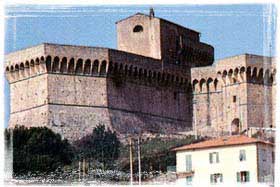 |
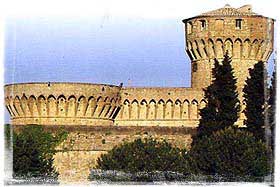 |
| 'Porta a Selci 'dominated by the 'Rocca Vecchia'. | The keep, core of the 'Rocca Nuova'. |
Volterra crown a hill at the confluence between the Val di Cecina and the Val D'era, in province of Pisa. It can be reached from Florence following the speedway FIRENZE-SIENA up to the exit 'Colle Valdelsa Sud' and then driving on the SS68 state road, called 'Volterrana', until the city walls.
Volterra is one of the main historical centers of Tuscany, earlier greatest 'metropolis', or better 'lucumonia', Etruscan, later Roman settlement. The town has known medieval, Medicean and Granducal memorable events, even if as a peripheral center. In this page I'll describe only the fortifications of the city, important points of reference of the military architecture, and not about the other innumerable monuments, of ancient and medieval times, that rises inside the city walls.
From any part we reach Volterra, we'll notice its profile, crowned by that of its Fortress, that rises at dominion of the surrounding territory, that make us immediately understand the importance the city has always had . The hill on which it rises, about 555 meters high, is the higher of this area, unapproachable from every side without being sighted with large advance.
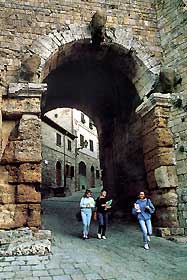 |
The Etruscan gate 'Porta dell'Arco' |
Volterra has Etruscan origins, at that time called the rich Velhatri, and its first town-wall enclosure, built during the 5th/4th century A.C., was extended for seven kilometers. This was the era of the city great territorial expansion that, with the aid of the minerals extracted from the mines of the near 'Colline Metallifere' (Metalliferous Hills), brought Volterra to dominate the other 'lucumonie' (big cities) of the zone as Populonia and all the Tyrrhenian coast from Piombino to Luni in the north of Tuscany. It was supposed that in 300 AC the city counted 25.000 inhabitants! In the 80 AC Volterra was, after a long siege, definitely conquered by the Roman, last big Etruscan lucumonia to capitulate. During the Longobard domination the city became a territory depending directly from the emperor, called 'gastaldato', but in the 10th century the history of Volterra turned into a negative period. Hungarian troops, calls to for give help in the war against the king of Italy Benengario I°, sacked the city, reducing it in downfall. After this episode, that left the town almost uninhabited, Volterra didn't succeed anymore to its primitive Etruscan greatness.
From the year 929, and for the three following centuries, the bishops had temporal power on the city and this situation was always recognized by varied Emperors. The center of the urban plant took form around the ancient 'acropoli', actually zone were the castle rises. In the year 1186, with the birth of the free-town realities, the bishops took the power to elect the consuls and beating coin. This was the era of a partial rebirth of Volterra, culminated in the reconstruction of the city walls. These on the southern side englobed the rests of the preexisting Etruscan-Roman enclosure, in which detaches today still the splendid Porta all'Arco (gate all'Arco) crowned by three lion-heads. Having to contain an inferior area, the town-walls were newly built on the the whole northern front and gifted of two gates, 'Fiorentina' (or S.Agnolo) to North and S.Francesco to West.
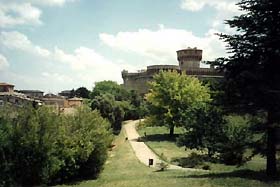 |
The 'Rocca Nuova' |
In 1343 was built the castle, today known as 'Rocca Vecchia' (Old Fortress), to the oriental vertex of the acropoli projected on the line of the Etruscan walls included the 'Porta a Selci'. At the end of the 13th century the struggles between Guelphs and Ghibellines, here present as in every other Tuscan city, were resolved with the victory of the first and this set the base to the future Florentine control of the city. The most important sign of the taking of the power by Florence was the construction of the complex of the Fortress, wanted in 1472 by Lorenzo il Magnifico, after the military conquest of the city.
Volterra is considered the first true 'Rocca' (a castle on a rock with bastionated defenses) built in Tuscany. From here started the ambitious program of Lorenzo for the strengthening of the borders of the Florentine territory. The fortification of Volterra had the double purpose to check the city and being important stronghold against Siena. At the head of the Florentine army that subdued Volterra was Federico da Montefeltro, commander that had already served in Romagna, an area where since some decades was in use the construction of bastionated fortresses in bricks, and perhaps owes to him the idea to erect here a fortress of this kind.
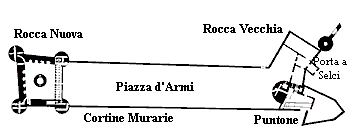
The construction began with the 'Rocca Nuova' (New Fortress), at the western border of the hill. Its plant has a trapezoidal form similar of a square with four cylindrical towers at the angles. Isolated at the center of the courtyard rises the keep, a round tower high the double of those angular, a reminiscence of the precedents strengthened enclosures of the 12/13th century. From the oriental side of the 'Rocca Nuova' depart two long parallel wall curtains that connect it to the preexisting castle, transformed in 'Rocca Vecchia'. This intermediary area to the two small fortress developed varied functions: it prevented the enemy to penetrate at the same altitude between the two fortresses , it connected the opposite vertexes of the complex, it was used as 'inner ward' and as space for protecting the population in case of yielding of the city entourage. The 'Rocca Vecchia', with trapezoidal plant, was endowed on the eastern side of a semipoligonal bastionated building (a big point toward the outside) to defense the 'Porta a Selci'. The complex, practically a fortified little town, is endowed with continuous machicoulis, projection from the wall made of stone which has openings through which the defenders can fire upon an enemy directly below. The Fortress has come practically intact to us thanks to the continuous restorations, in fact it remained always in use up to our days first as barracks and then as jail. Being center of an institute of punishment, the complex is visible only from the outside.
| Back to Homepage |
| Back to Castles Index |

